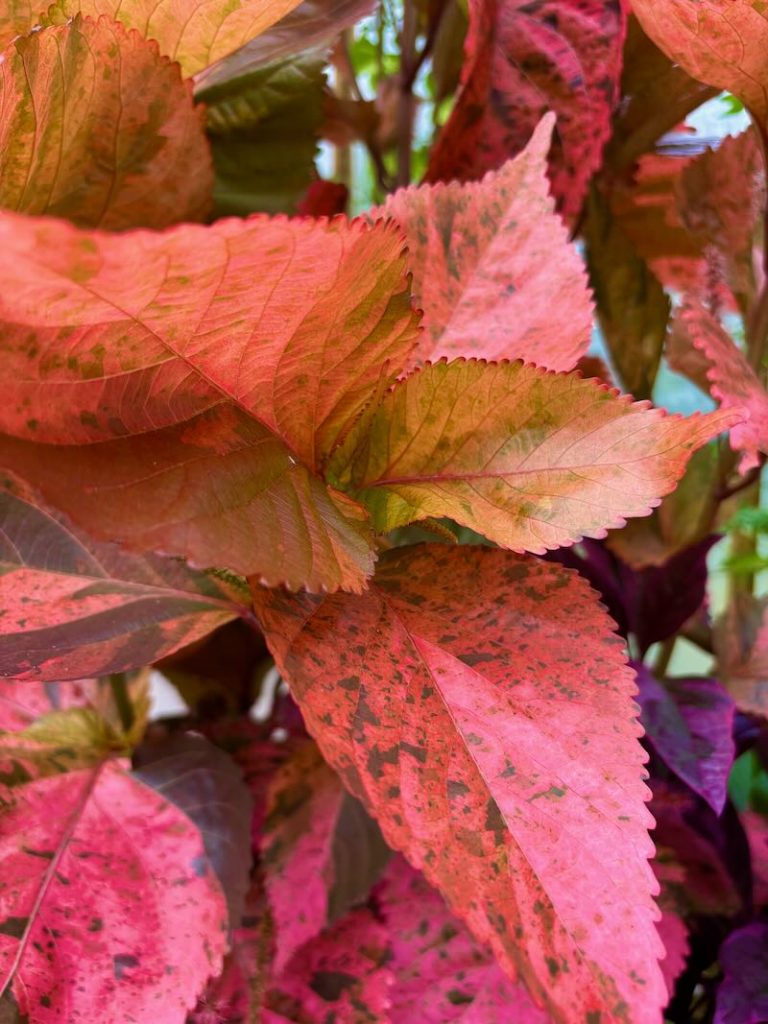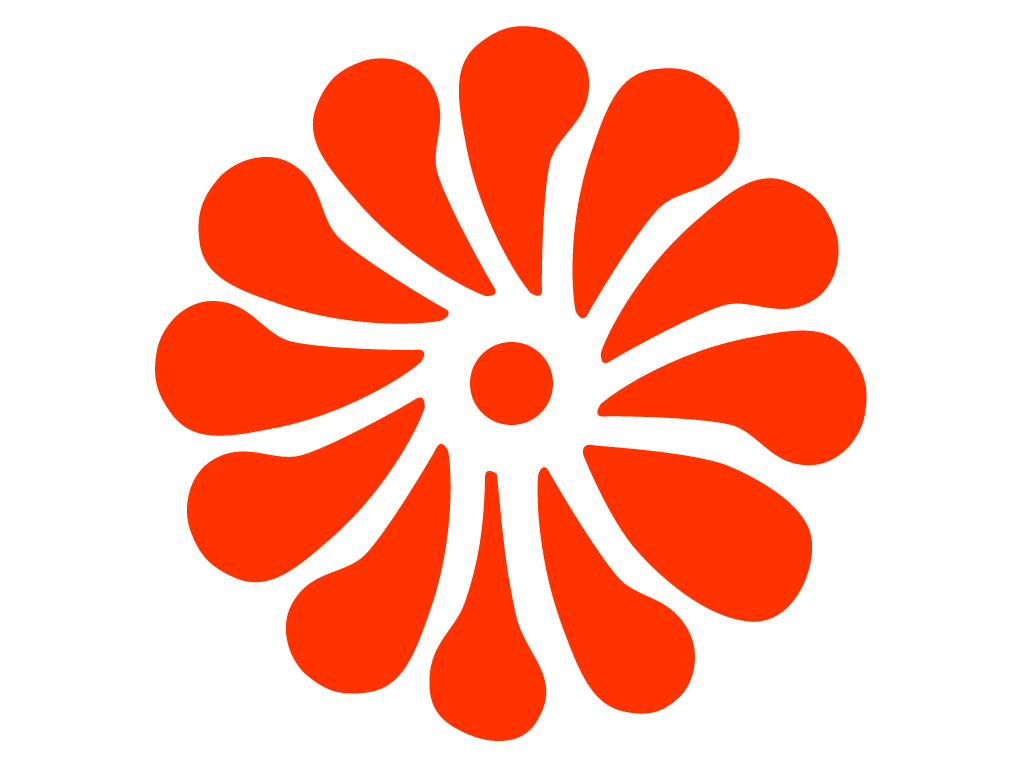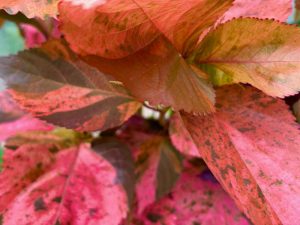Acalypha wilkesiana ‘Bronze Pink’: A Striking Copperleaf for Colorful Gardens
Acalypha wilkesiana ‘Bronze Pink’, also known as Copperleaf, Wilkes’ Acalypha, or Jacob’s Coat, is a vibrant tropical shrub grown for its bold foliage rather than its flowers. This colorful plant belongs to the Euphorbiaceae family, also called the spurge family. Native to Fiji and nearby South Pacific islands, it thrives in warm, frost-free regions, where it grows as an evergreen shrub. In cooler climates, gardeners often cultivate it as an annual or overwinter it indoors.
With its dazzling bronze, copper, burgundy, and pink leaves, ‘Bronze Pink’ immediately catches attention in the garden. It offers year-round color in tropical landscapes and works equally well as a container or hanging basket plant in temperate zones. Gardeners prize it for its upright, spreading habit and its ability to provide bold contrast in mixed plantings.
Description of Acalypha wilkesiana ‘Bronze Pink’
Acalypha wilkesiana ‘Bronze Pink’ grows quickly and forms an upright, bushy shrub. In frost-free climates, it can reach heights of 3–4.5 meters (10–15 feet) with a similar spread. In cooler areas where it is grown as an annual, it typically grows 1–1.2 meters (40–48 inches) in a single season. The habit is upright but spreading, creating a dense and lush display.
The leaves of this cultivar are its greatest attraction. Heart-shaped and serrated, they grow 10–20 centimeters (4–8 inches) long. The foliage features dramatic variegation, emerging coppery bronze in spring and maturing to olive green splashed with burgundy and streaked with hot pink. The shifting tones throughout the seasons keep the plant visually dynamic. Unlike many annual bedding plants, the foliage remains attractive all year in frost-free climates.
While Acalypha does produce flowers, they are small and inconspicuous. The blooms appear as slender reddish-pink spikes from spring through fall, but they remain overshadowed by the vivid foliage. Gardeners grow this plant primarily for its leaves, which act as a living tapestry of color in garden beds, borders, and containers.
Background and Naming
The genus Acalypha derives from the Greek word for nettle, reflecting the resemblance of its leaves to those of stinging nettles. The species epithet wilkesiana honors Admiral Charles Wilkes, who led explorations of the South Pacific in the 1800s.
In its native range, Acalypha wilkesiana grows as a large tropical shrub, often forming part of hedges or natural screens. Over time, breeders have developed several cultivars, including ‘Bronze Pink’, each selected for unique foliage colors and patterns.
Growth Habit and Environmental Tolerances
Acalypha wilkesiana ‘Bronze Pink’ grows vigorously in the right conditions. In tropical gardens, it becomes a long-lived evergreen shrub with a lifespan of around 30 years. It tolerates pruning well, allowing gardeners to maintain it as a hedge, a specimen shrub, or even a large container plant.
This cultivar thrives in full sun to partial shade, though the foliage shows the best color in brighter light. It tolerates heat well, making it an excellent choice for warm, humid regions. While it appreciates evenly moist soil, it shows some drought tolerance once established. In urban areas, it adapts well to slightly polluted air and different soil conditions, as long as drainage is good.
However, it is not cold hardy. Temperatures below 10°C (50°F) can damage the plant, and frost will kill it to the ground. For this reason, gardeners in USDA Zones 10–11 grow it outdoors year-round, while those in cooler climates treat it as an annual or bring it indoors for winter.
Ornamental Features
The most striking feature of Copperleaf ‘Bronze Pink’ is its foliage. The mix of copper, burgundy, olive, and pink creates a painterly effect, making it stand out among other tropicals. When paired with green-leaved shrubs or fine-textured plants, the bold colors pop even more.
The upright spreading habit works well for creating colorful screens, background plantings, or dramatic focal points. Its texture blends well in mixed borders, yet its strong color ensures it never disappears into the background.
Landscape Uses
Gardeners use Acalypha wilkesiana ‘Bronze Pink’ in many ways:
- As an accent plant in tropical or subtropical landscapes.
- Mass planted for a hedge or colorful backdrop.
- In mixed borders, where its variegated leaves provide contrast.
- Planted in large containers or decorative pots on patios.
- Part of hanging baskets, where the foliage can spill over the edges.
In frost-free climates, it is often used as a permanent shrub in landscaping. In cooler areas, it serves as a fast-growing annual that brings instant color to summer gardens.
How to Grow Acalypha wilkesiana ‘Bronze Pink’
Light Requirements
Plant ‘Bronze Pink’ in full sun to partial shade. At least 6 hours of direct sunlight daily ensures the brightest foliage colors. Too much shade can cause the colors to fade, leaving the plant greener and less vibrant.
Soil Needs
This plant grows best in rich, fertile soil that drains well. Amend the soil with compost or organic matter before planting to improve fertility and drainage. While it tolerates a range of soil pH levels, slightly acidic to neutral soils (pH 6.0–7.5) are ideal.
For container growing, use a high-quality potting mix that retains moisture but drains freely. Ensure the pot has drainage holes to prevent waterlogging.
Watering
Keep the soil consistently moist, especially during hot weather. Water deeply once or twice a week, adjusting for rainfall and climate conditions. In containers, water more frequently, as potting mixes dry out faster than garden soil. Avoid letting the soil dry out completely, as this can cause leaf drop.
During winter, if overwintered indoors, reduce watering slightly. Keep the soil just barely moist, never soggy.
Fertilizing
Feed regularly to maintain vibrant foliage. Apply a balanced, water-soluble fertilizer every two weeks during the growing season (spring through fall). Alternatively, use a slow-release granular fertilizer three times per year. In containers, fertilizing becomes even more important, as nutrients leach out with frequent watering.
Pruning and Maintenance
Pinch back young stems to encourage branching and create a fuller shape. In early spring, prune away dead or damaged branches and shape the plant. You can cut it back by half to promote new growth and control size.
Use sharp, sterilized pruning shears to avoid spreading disease. Regular pruning also keeps the plant from becoming too leggy and helps maintain its ornamental appeal.
Propagation of Acalypha wilkesiana ‘Bronze Pink’
You can propagate Acalypha wilkesiana ‘Bronze Pink’ easily through stem cuttings. Take semi-hardwood cuttings 10–15 centimeters (4–6 inches) long in spring or early summer. Remove the lower leaves and dip the cut end in rooting hormone before planting in a well-draining potting mix. Keep the cuttings moist and warm until roots develop, usually within a few weeks.
Propagation by cuttings ensures the new plants remain true to the ‘Bronze Pink’ cultivar, preserving its unique foliage patterns.
Pests and Diseases
Like many tropical shrubs, ‘Bronze Pink’ attracts a few common pests. Whiteflies, mealybugs, spider mites, and scale insects may infest the leaves. Regularly inspect your plant and treat problems early with insecticidal soap or horticultural oil. Increasing humidity indoors can help prevent spider mite infestations.
Caterpillars occasionally chew the leaves, but hand-picking usually controls them.
Diseases are uncommon, though leaf spot and powdery mildew may occur in damp, poorly ventilated conditions. To prevent fungal issues, avoid overhead watering and provide good air circulation.
Other Considerations
Be aware that parts of Acalypha wilkesiana ‘Bronze Pink’ are toxic to humans and animals if ingested. Plant it with care in gardens where children and pets play.
This shrub is not suitable for frost-prone regions unless grown in containers that can be moved indoors. When grown indoors, place it in a bright location and maintain warm temperatures to mimic its tropical environment.
Cultural Significance and Longevity
In tropical landscapes, Copperleaf plants like ‘Bronze Pink’ often feature in formal gardens, resort plantings, and public spaces because of their durability and bold color. With proper care, these shrubs can live for decades, becoming permanent features of the landscape.
Conclusion
Acalypha wilkesiana ‘Bronze Pink’, or Copperleaf, offers gardeners a bold and colorful option for year-round foliage interest. Its coppery-bronze leaves splashed with burgundy and pink create an unforgettable display in landscapes, containers, or hanging baskets. With proper care in terms of sunlight, watering, and fertilization, this fast-growing tropical shrub provides lasting beauty.
Whether you grow it as a permanent shrub in a warm climate or as an annual accent in a cooler region, ‘Bronze Pink’ makes a stunning addition to any garden design. By understanding its needs and growth habits, gardeners can enjoy its vivid foliage for many years.



